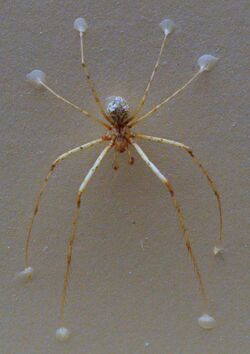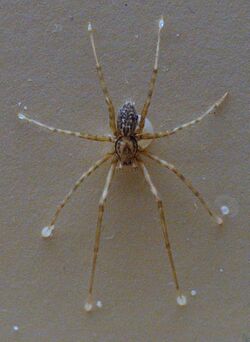Biology:Stiphidion facetum
| Stiphidion facetum | |
|---|---|

| |
| male | |

| |
| female | |
| Scientific classification | |
| Domain: | Eukaryota |
| Kingdom: | Animalia |
| Phylum: | Arthropoda |
| Subphylum: | Chelicerata |
| Class: | Arachnida |
| Order: | Araneae |
| Infraorder: | Araneomorphae |
| Family: | Stiphidiidae |
| Genus: | Stiphidion |
| Species: | S. facetum
|
| Binomial name | |
| Stiphidion facetum E. Simon, 1902[1]
| |
Stiphidion facetum is a species of spider in the genus Stiphidion native to Australia and also found in New Zealand.[2]
See also
Invasions
This species of spider is extremely competitive and ready to invade foreign webs. They are knowledgeable in understanding that already existing spider webs are made in prey rich environments so there are always incoming resources. The species that are more likely to survive invading another's home are the larger sheet web spiders[3].
Diet
This species are greatly effected by their mother. Depending on the maternal diet it will drastically influence its survivorship. When the female consumes high protein prey their offspring are more likely to survive longer, daughters were more reproductively successful, and grew much faster[4].
References
- ↑ "Taxon details Stiphidion facetum Simon, 1902", World Spider Catalog (Natural History Museum Bern), http://www.wsc.nmbe.ch/species/35626, retrieved 2016-04-15
- ↑ "Spider (Sombrero)(Stiphidion facetum)". Taranaki Educational Resource: Research, Analysis and Information Network. http://www.terrain.net.nz/friends-of-te-henui-group/spiders/stiphidion-facetum.html. Retrieved 2012-05-17.
3. EICHENBERGER, B., SIEGENTHALER, E., & SCHMIDT-ENTLING, M. H. (2009). Body size determines the outcome of competition for webs among alien and native sheetweb spiders (Araneae: Linyphiidae). Ecological Entomology, 34(3), 363–368.
4. Wen, L., Zhang, Z., Zhang, S., Liu, F., Jiao, X., & Li, D. (2020). Influence of maternal diet on offspring survivorship, growth, and reproduction in a sheetweb spider. Biology Open, 9(11).
Wikidata ☰ Q2054489 entry
 |

